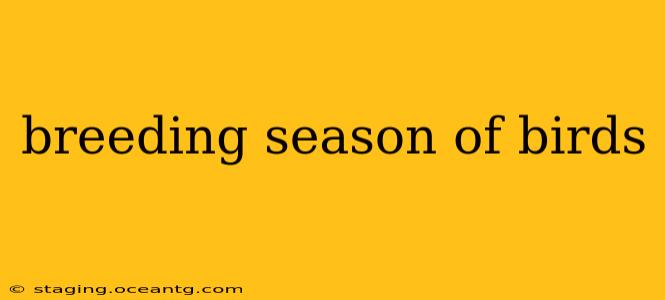Birds' breeding seasons are a fascinating spectacle of nature, showcasing vibrant displays, intricate nest building, and the tireless dedication of parents to their young. Understanding the factors that influence these seasonal events is key to appreciating the complex lives of avian species. This guide explores the breeding season of birds, covering everything from timing and triggers to the various behaviors involved.
What triggers the breeding season in birds?
Several key factors orchestrate the onset of a bird's breeding season. Primarily, photoperiod, or the length of daylight, plays a crucial role. As days lengthen in spring, hormonal changes are triggered, stimulating reproductive activity. This is a remarkably consistent trigger across many bird species, ensuring breeding coincides with optimal conditions for raising young. Temperature is also a significant factor; warmer temperatures often signal the start of the breeding season, particularly in regions with distinct seasons. Food availability is another critical element. Abundant food resources are essential for successful breeding, providing the energy needed for egg production, incubation, and chick rearing. Finally, rainfall influences breeding in many bird species, especially those inhabiting arid or semi-arid regions where water availability is crucial for survival and reproduction.
When is the breeding season for birds?
The timing of the breeding season varies considerably among bird species and geographical locations. Generally, breeding occurs in spring and summer in temperate regions, coinciding with the abundance of food and suitable nesting sites. However, in tropical regions, breeding can occur year-round, although it often peaks during certain seasons influenced by rainfall or food availability. Specific breeding periods can range from a few weeks to several months, depending on the species and environmental conditions. For instance, migratory birds often time their breeding to coincide with their arrival at their breeding grounds, ensuring an optimal window for raising young before their return migration.
How long does the bird breeding season last?
The duration of a bird's breeding season is highly species-specific. Some birds may have a relatively short breeding season lasting only a few weeks, while others may breed for several months. Factors influencing the duration include the species' life history strategy, food availability, and the prevailing environmental conditions. Birds with multiple broods per season will naturally have a longer breeding period. Species that require extensive parental care for their young will often have shorter breeding seasons, as the energy demands are substantial.
What are the signs of birds in breeding season?
Identifying birds in breeding season often involves observing specific behavioral changes. Many species exhibit striking plumage changes, with males often developing brighter colors or distinctive breeding ornaments to attract mates. Birds also engage in various courtship displays, including elaborate songs, dances, and aerial acrobatics. The construction of nests is another prominent sign, with birds diligently gathering materials and building structures tailored to their species' needs. Increased territoriality is also common, with birds actively defending their breeding territories from rivals. Finally, the presence of eggs and chicks is the most definitive sign of birds actively engaged in breeding.
What are the different stages of the bird breeding season?
The bird breeding season encompasses several distinct stages:
- Pre-breeding: This phase involves hormonal changes, territorial establishment, and the formation of breeding pairs.
- Nest building: Birds construct nests tailored to their species' requirements and the available habitat.
- Egg laying: Females lay eggs, typically in clutches of a specific number for the species.
- Incubation: Parents incubate the eggs, providing warmth necessary for embryonic development.
- Hatching: Chicks emerge from the eggs, initiating a phase of intense parental care.
- Fledgling: Young birds develop the ability to fly and leave the nest.
- Post-breeding: After the young are independent, birds may molt, disperse, or migrate.
Understanding the intricate details of a bird's breeding season provides a deeper appreciation for the complexity and resilience of avian life. By observing these fascinating behaviors, we gain invaluable insights into the ecology and evolution of these remarkable creatures.
